2017 NISSAN ROGUE ECU
[x] Cancel search: ECUPage 522 of 547

Steps for determining correct load
limit
1. Locate the statement “The combinedweight of occupants and cargo
should never exceed XXX lbs or XXX
kg” on your vehicle’s Tire and Load-
ing Information label.
2. Determine the combined weight of the driver and passengers that will be
riding in your vehicle.
3. Subtract the combined weight of the driver and passengers from XXX lbs
or XXX kg.
4. The resulting figure equals the avail- able amount of cargo and luggage
load capacity. For example, if the
XXX amount equals 1,400 lbs. and
there will be five 150 lb. passengers
in your vehicle, the amount of avail-
able cargo and luggage load capac-
ity is 650 lbs. (1,400-750 (5 X 150)
= 650 lbs) or (640-340 (5 X 70) =
300 kg.) 5. Determine the combined weight of
luggage and cargo being loaded on
the vehicle. That weight may not
safely exceed the available cargo and
luggage load capacity calculated in
step 4.
6. If your vehicle will be towing a trailer, load from your trailer will be trans-
ferred to your vehicle. Consult this
manual to determine how this re-
duces the available cargo and lug-
gage load capacity of your vehicle.
Before driving a loaded vehicle, confirm
that you do not exceed the Gross Vehicle
Weight Rating (GVWR) or the Gross Axle
Weight Rating (GAWR) for your vehicle.
For additional information, refer to “Mea-
surement of weights” in this section.
Also check tires for proper inflation pres-
sures. For additional information, refer to
the “Tire and loading information label” in
this section.
SECURING THE LOAD
There are luggage hooks located in the cargo
area as shown. The hooks can be used to secure
cargo with ropes or other types of straps.
Do not apply a total load of more than
6.5 lbs. (29 N) to a single metal floor hook
when securing cargo.
Cargo area luggage hooks
LIC2629
Technical and consumer information10-15
Page 523 of 547
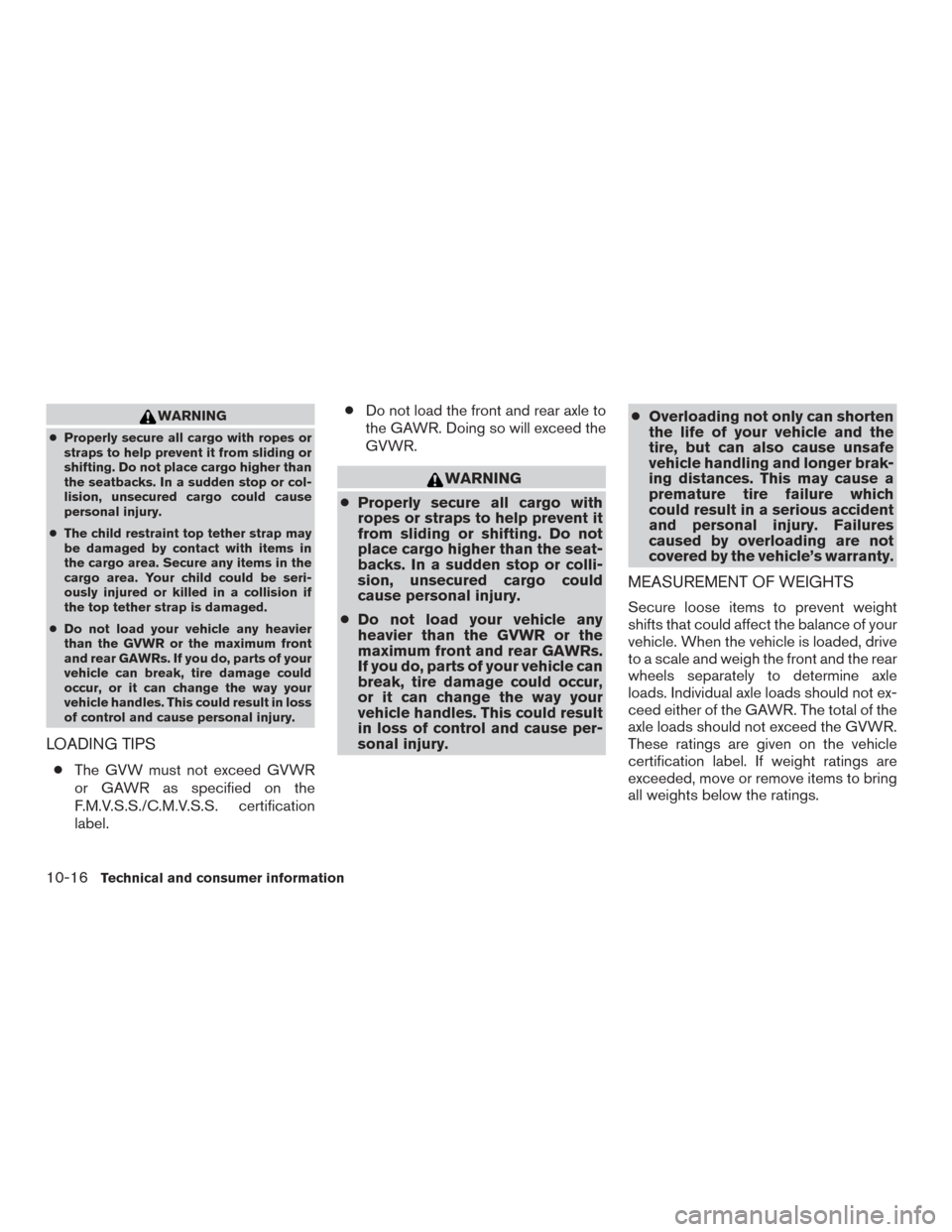
WARNING
●Properly secure all cargo with ropes or
straps to help prevent it from sliding or
shifting. Do not place cargo higher than
the seatbacks. In a sudden stop or col-
lision, unsecured cargo could cause
personal injury.
● The child restraint top tether strap may
be damaged by contact with items in
the cargo area. Secure any items in the
cargo area. Your child could be seri-
ously injured or killed in a collision if
the top tether strap is damaged.
● Do not load your vehicle any heavier
than the GVWR or the maximum front
and rear GAWRs. If you do, parts of your
vehicle can break, tire damage could
occur, or it can change the way your
vehicle handles. This could result in loss
of control and cause personal injury.
LOADING TIPS
● The GVW must not exceed GVWR
or GAWR as specified on the
F.M.V.S.S./C.M.V.S.S. certification
label. ●
Do not load the front and rear axle to
the GAWR. Doing so will exceed the
GVWR.
WARNING
● Properly secure all cargo with
ropes or straps to help prevent it
from sliding or shifting. Do not
place cargo higher than the seat-
backs. In a sudden stop or colli-
sion, unsecured cargo could
cause personal injury.
● Do not load your vehicle any
heavier than the GVWR or the
maximum front and rear GAWRs.
If you do, parts of your vehicle can
break, tire damage could occur,
or it can change the way your
vehicle handles. This could result
in loss of control and cause per-
sonal injury. ●
Overloading not only can shorten
the life of your vehicle and the
tire, but can also cause unsafe
vehicle handling and longer brak-
ing distances. This may cause a
premature tire failure which
could result in a serious accident
and personal injury. Failures
caused by overloading are not
covered by the vehicle’s warranty.
MEASUREMENT OF WEIGHTS
Secure loose items to prevent weight
shifts that could affect the balance of your
vehicle. When the vehicle is loaded, drive
to a scale and weigh the front and the rear
wheels separately to determine axle
loads. Individual axle loads should not ex-
ceed either of the GAWR. The total of the
axle loads should not exceed the GVWR.
These ratings are given on the vehicle
certification label. If weight ratings are
exceeded, move or remove items to bring
all weights below the ratings.
10-16
Technical and consumer information
Page 528 of 547

TOWING SAFETY
Trailer hitch
Your vehicle may be equipped with an optional
trailer tow package. The trailer tow package in-
cludes a receiver-type frame mounted hitch. This
hitch is rated for the maximum towing capacity of
this vehicle when the proper towing equipment is
used. Choose a proper ball mount and hitch ball
that is rated for the trailer to be towed. Genuine
NISSAN ball mounts and hitch balls are available
from a NISSAN dealer.
If your vehicle is not equipped with the optional
trailer tow package, check the towing capacity of
your bumper hitch or receiver-type frame
mounted hitch. Choose a proper hitch for your
vehicle and trailer. A Genuine NISSAN trailer
hitch is available from a NISSAN dealer. Make
sure the trailer hitch is securely attached to the
vehicle to help avoid personal injury or property
damage due to sway caused by crosswinds,
rough road surfaces or passing trucks.
WARNING
Trailer hitch components have specific
weight ratings. Your vehicle may be ca-
pable of towing a trailer heavier than the
weight rating of the hitch components.
Never exceed the weight rating of the
hitch components. Doing so can cause
serious personal injury or property
damage.
Hitch ball
Choose a hitch ball of the proper size and weight
rating for your trailer:● The required hitch ball size is stamped on
most trailer couplers. Most hitch balls also
have the size printed on the top of the ball.
● Choose the proper class hitch ball based on
the trailer weight.
● The diameter of the threaded shank of the
hitch ball must be matched to the ball mount
hole diameter. The hitch ball shank should
be no more than 1/16” smaller than the hole
in the ball mount. ●
The threaded shank of the hitch ball must be
long enough to be properly secured to the
ball mount. There should be at least 2
threads showing beyond the lock washer
and nut.
Ball mount
The hitch ball is attached to the ball mount and
the ball mount is inserted into the hitch receiver.
Choose a proper class ball mount based on the
trailer weight. Additionally, the ball mount should
be chosen to keep the trailer tongue level with the
ground.
Weight carrying hitches
A weight carrying or “dead weight” ball mount is
one that is designed to carry the whole amount of
tongue weight and gross weight directly on the
ball mount and on the receiver.
Weight distribution hitch
This type of hitch is also called a “load-leveling” or
“equalizing” hitch. A set of bars attach to the ball
mount and to the trailer to distribute the tongue
weight (hitch weight) of your trailer. Many ve-
hicles can’t carry the full tongue weight of a given
trailer, and need some of the tongue weight
transferred through the frame and pushing down
on the front wheels. This gives stability to the tow
vehicle.
Technical and consumer information10-21
Page 530 of 547
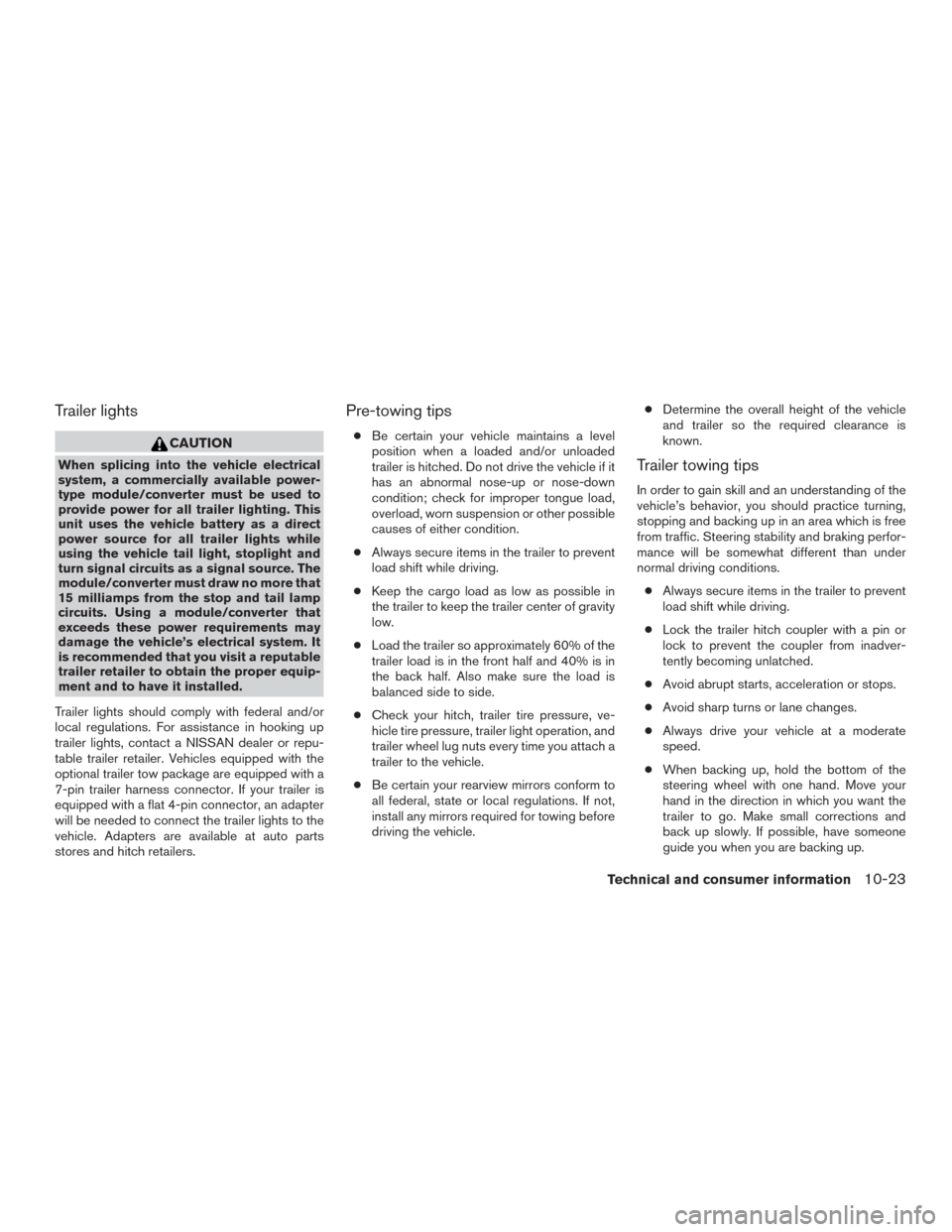
Trailer lights
CAUTION
When splicing into the vehicle electrical
system, a commercially available power-
type module/converter must be used to
provide power for all trailer lighting. This
unit uses the vehicle battery as a direct
power source for all trailer lights while
using the vehicle tail light, stoplight and
turn signal circuits as a signal source. The
module/converter must draw no more that
15 milliamps from the stop and tail lamp
circuits. Using a module/converter that
exceeds these power requirements may
damage the vehicle’s electrical system. It
is recommended that you visit a reputable
trailer retailer to obtain the proper equip-
ment and to have it installed.
Trailer lights should comply with federal and/or
local regulations. For assistance in hooking up
trailer lights, contact a NISSAN dealer or repu-
table trailer retailer. Vehicles equipped with the
optional trailer tow package are equipped with a
7-pin trailer harness connector. If your trailer is
equipped with a flat 4-pin connector, an adapter
will be needed to connect the trailer lights to the
vehicle. Adapters are available at auto parts
stores and hitch retailers.
Pre-towing tips
● Be certain your vehicle maintains a level
position when a loaded and/or unloaded
trailer is hitched. Do not drive the vehicle if it
has an abnormal nose-up or nose-down
condition; check for improper tongue load,
overload, worn suspension or other possible
causes of either condition.
● Always secure items in the trailer to prevent
load shift while driving.
● Keep the cargo load as low as possible in
the trailer to keep the trailer center of gravity
low.
● Load the trailer so approximately 60% of the
trailer load is in the front half and 40% is in
the back half. Also make sure the load is
balanced side to side.
● Check your hitch, trailer tire pressure, ve-
hicle tire pressure, trailer light operation, and
trailer wheel lug nuts every time you attach a
trailer to the vehicle.
● Be certain your rearview mirrors conform to
all federal, state or local regulations. If not,
install any mirrors required for towing before
driving the vehicle. ●
Determine the overall height of the vehicle
and trailer so the required clearance is
known.
Trailer towing tips
In order to gain skill and an understanding of the
vehicle’s behavior, you should practice turning,
stopping and backing up in an area which is free
from traffic. Steering stability and braking perfor-
mance will be somewhat different than under
normal driving conditions.
● Always secure items in the trailer to prevent
load shift while driving.
● Lock the trailer hitch coupler with a pin or
lock to prevent the coupler from inadver-
tently becoming unlatched.
● Avoid abrupt starts, acceleration or stops.
● Avoid sharp turns or lane changes.
● Always drive your vehicle at a moderate
speed.
● When backing up, hold the bottom of the
steering wheel with one hand. Move your
hand in the direction in which you want the
trailer to go. Make small corrections and
back up slowly. If possible, have someone
guide you when you are backing up.
Technical and consumer information10-23
Page 535 of 547
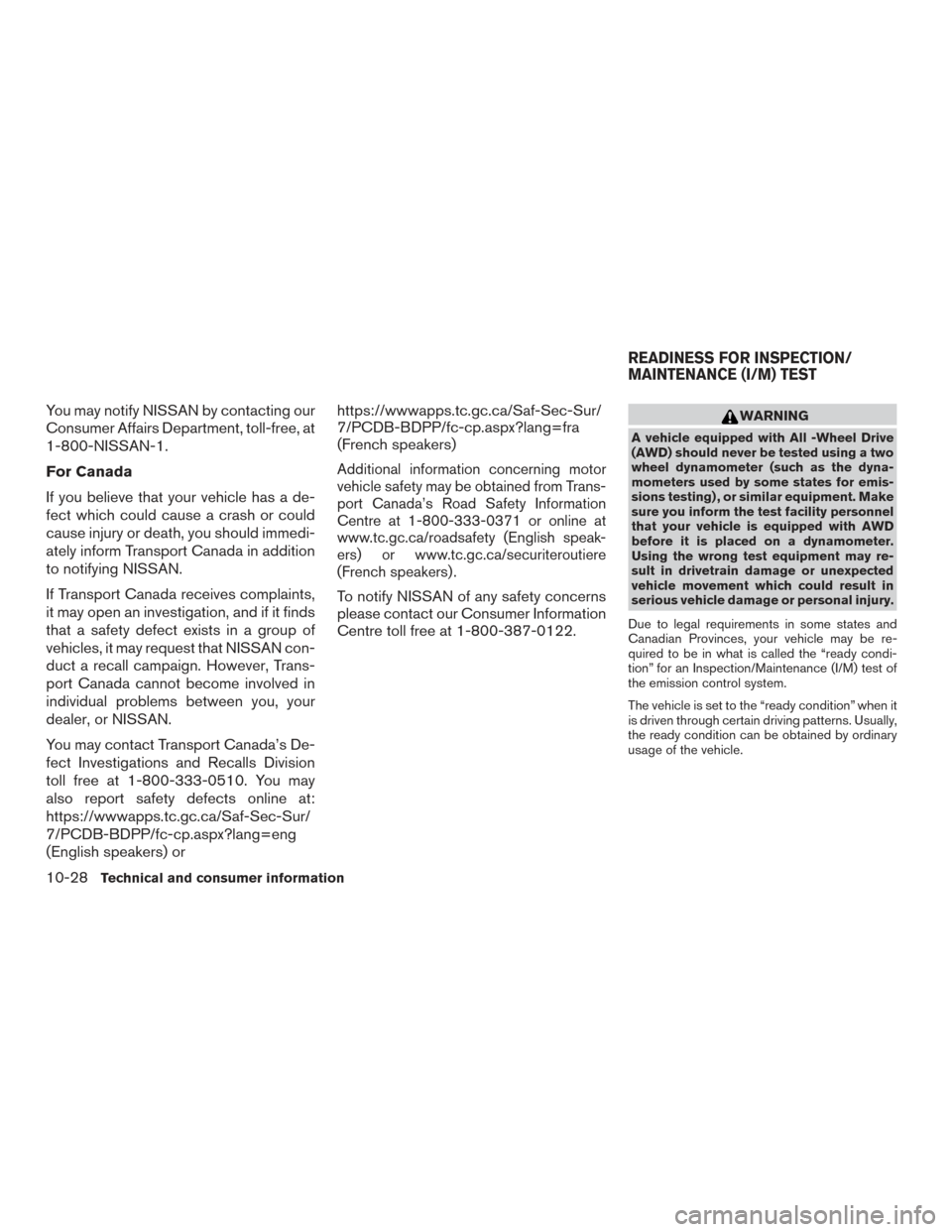
You may notify NISSAN by contacting our
Consumer Affairs Department, toll-free, at
1-800-NISSAN-1.
For Canada
If you believe that your vehicle has a de-
fect which could cause a crash or could
cause injury or death, you should immedi-
ately inform Transport Canada in addition
to notifying NISSAN.
If Transport Canada receives complaints,
it may open an investigation, and if it finds
that a safety defect exists in a group of
vehicles, it may request that NISSAN con-
duct a recall campaign. However, Trans-
port Canada cannot become involved in
individual problems between you, your
dealer, or NISSAN.
You may contact Transport Canada’s De-
fect Investigations and Recalls Division
toll free at 1-800-333-0510. You may
also report safety defects online at:
https://wwwapps.tc.gc.ca/Saf-Sec-Sur/
7/PCDB-BDPP/fc-cp.aspx?lang=eng
(English speakers) orhttps://wwwapps.tc.gc.ca/Saf-Sec-Sur/
7/PCDB-BDPP/fc-cp.aspx?lang=fra
(French speakers)
Additional information concerning motor
vehicle safety may be obtained from Trans-
port Canada’s Road Safety Information
Centre at 1-800-333-0371 or online at
www.tc.gc.ca/roadsafety (English speak-
ers) or www.tc.gc.ca/securiteroutiere
(French speakers) .
To notify NISSAN of any safety concerns
please contact our Consumer Information
Centre toll free at 1-800-387-0122.
WARNING
A vehicle equipped with All -Wheel Drive
(AWD) should never be tested using a two
wheel dynamometer (such as the dyna-
mometers used by some states for emis-
sions testing) , or similar equipment. Make
sure you inform the test facility personnel
that your vehicle is equipped with AWD
before it is placed on a dynamometer.
Using the wrong test equipment may re-
sult in drivetrain damage or unexpected
vehicle movement which could result in
serious vehicle damage or personal injury.
Due to legal requirements in some states and
Canadian Provinces, your vehicle may be re-
quired to be in what is called the “ready condi-
tion” for an Inspection/Maintenance (I/M) test of
the emission control system.
The vehicle is set to the “ready condition” when it
is driven through certain driving patterns. Usually,
the ready condition can be obtained by ordinary
usage of the vehicle.
READINESS FOR INSPECTION/
MAINTENANCE (I/M) TEST
10-28Technical and consumer information
Page 538 of 547

11 Index
2nd row bench seat adjustment.........1-6
A
Aiming control, headlights ........2-43,2-44
Air bag (See supplemental restraint
system) .....................1-46
Air bag system Front (See supplemental front impact
air bag system) ...............1-53
Airbagwarninglabels.............1-63
Airbagwarninglight...........1-64,2-16
Air bag warning light, supplemental . .1-64, 2-16
Air cleaner housing filter ............8-15
Air conditioner Air conditioner operation ..........4-35
Air conditioner specification label ....10-12
Air conditioner system refrigerant and
oil recommendations ............10-7
Air conditioner system refrigerant
recommendations ..............10-7
Heater and air conditioner
controls................4-33,4-41
Servicing air conditioner ..........4-43
Airflowcharts..................4-37
Alarm system
(See vehicle security system) .........2-34
All-Wheel Drive .................5-98
Anchor point locations .............1-30
Antenna .....................4-76
Antifreeze ...................5-111
Anti-lock brake warning light ..........2-12Anti-lock Braking System (ABS)
.......5-103
Apps .......................4-76
Armrests .....................1-6
AroundView®Monitor.............4-17
Audible reminders ...............2-19
Audio system ..................4-43
AMradioreception.............4-44
Bluetooth®audio..........4-72,4-73
Bluetooth® streaming audio ....4-72,4-73
Compact disc (CD) player .....4-55,4-62
FM/AM/SAT radio with compact disc (CD)
player.................4-52,4-57
FMradioreception.............4-44
iPod® Player .............4-67,4-69
iPod® player operation .......4-67,4-69
Radio ....................4-43
USB interface ............4-63,4-65
USB (Universal Serial Bus) Connection
Port..................4-63,4-65
Autolight switch .................2-40
Automatic Automatic drive positioner .....3-41,3-43
Automatic power window switch .....2-63
Automatic anti-glare inside mirror .......3-39
Automatic door locks ..............3-7
Automatic drive positioner .......3-41,3-43
AUXjack ....................4-63
AWD.......................5-98
B
Battery .................5- 111, 8-11Charge warning light
............2-13
Battery replacement ..............8-21
Keyfob ...................8-21
NISSAN Intelligent Key® ......8-23,8-24
Before starting the engine ...........5-18
Belt (See drive belt) ..............8-13
Blind Spot Warning (BSW) warning
system......................5-37
Bluetooth® audio ............4-72,4-73
Bluetooth® hands-free phone
system..................4-81,4-94
Bluetooth® streaming audio with Navigation
System .....................4-73
Boosterseats..................1-43
Brake Anti-lock Braking System (ABS) .....5-103
Brake fluid ..................8-9
Brakelight(Seestoplight).........8-27
Brake system ...............5-103
Brakewarninglight.............2-12
Brakewearindicators........2-19,8-18
Parking brake operation ..........5-25
Self-adjusting brakes ............8-18
Brake assist ..................5-104
Brake fluid ....................8-9
Brakes ......................
8-18
Brake system .................5-103
Break-inschedule ...............5-96
Brightness/contrast button ...........4-10
Brightness control Instrument panel ..............2-45
Bulb check/instrument panel ..........2-11
Bulbreplacement................8-27
Page 541 of 547
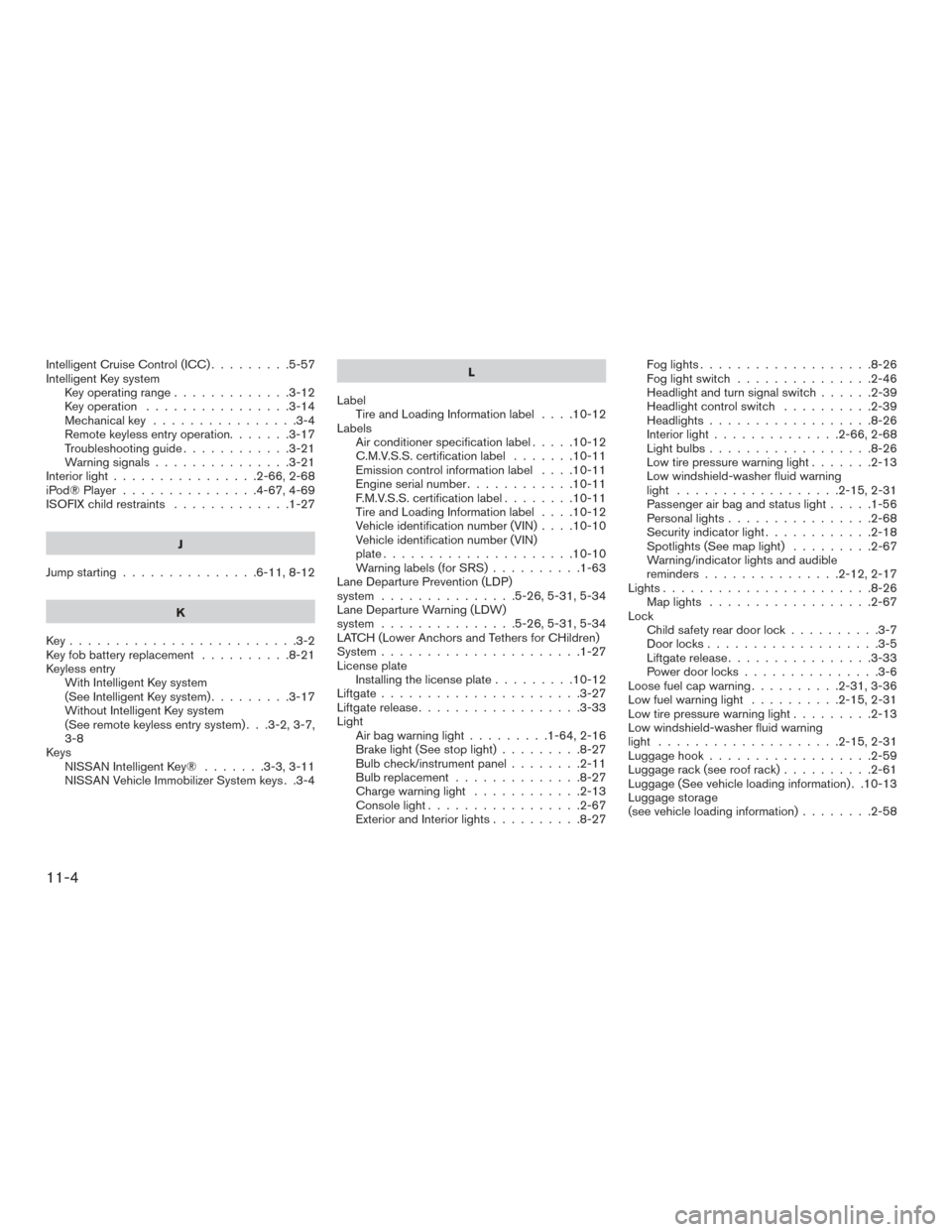
Intelligent Cruise Control (ICC).........5-57
Intelligent Key system Key operating range .............3-12
Key operation ................3-14
Mechanicalkey ................3-4
Remote keyless entry operation.......3-17
Troubleshooting guide ............3-21
Warning signals ...............3-21
Interiorlight................2-66,2-68
iPod®Player ...............4-67,4-69
ISOFIX child restraints .............1-27
J
Jump starting ...............6-11,8-12
K
Key.........................3-2
Key fob battery replacement ..........8-21
Keyless entry With Intelligent Key system
(See Intelligent Key system) .........3-17
Without Intelligent Key system
(See remote keyless entry system) . . .3-2, 3-7,
3-8
Keys NISSAN Intelligent Key® .......3-3,3-11
NISSAN Vehicle Immobilizer System keys . .3-4 L
Label Tire and Loading Information label ....10-12
Labels Air conditioner specification label .....10-12
C.M.V.S.S. certification label .......10-11
Emission control information label ....10-11
Engine serial number ............10-11
F.M.V.S.S. certification label ........10-11
Tire and Loading Information label ....10-12
Vehicle identification number (VIN) ....10-10
Vehicle identification number (VIN)
plate.....................10-10
Warning labels (for SRS) ..........1-63
Lane Departure Prevention (LDP)
system ...............5-26,5-31,5-34
Lane Departure Warning (LDW)
system ...............5-26,5-31,5-34
LATCH (Lower Anchors and Tethers for CHildren)
System ......................1-27
License plate Installing the license plate .........10-12
Liftgate ......................3-27
Liftgate release ..................3-33
Light Air bag warning light .........1-64,2-16
Brake light (See stop light) .........8-27
Bulb check/instrument panel ........2-11
Bulbreplacement..............8-27
Charge warning light ............2-13
Consolelight.................2-67
Exterior and Interior lights ..........8-27 Foglights...................8-26
Fog light switch
...............2-46
Headlightandturnsignalswitch......2-39
Headlight control switch ..........2-39
Headlights..................8-26
Interiorlight..............2-66,2-68
Lightbulbs..................8-26
Low tire pressure warning light .......2-13
Low windshield-washer fluid warning
light ..................2-15,2-31
Passenger air bag and status light .....1-56
Personal lights ................2-68
Security indicator light ............2-18
Spotlights(Seemaplight) .........2-67
Warning/indicator lights and audible
reminders ...............2-12,2-17
Lights.......................8-26 Maplights ..................2-67
Lock Child safety rear door lock ..........3-7
Door locks ...................3-5
Liftgate release ................3-33
Power door locks ...............3-6
Loose
fuel cap warning ..........2-31,3-36
Low fuel warning light ..........2-15,2-31
Low tire pressure warning light .........2-13
Low windshield-washer fluid warning
light ....................2-15,2-31
Luggage hook ..................2-59
Luggage rack (see roof rack) ..........2-61
Luggage (See vehicle loading information) . .10-13
Luggage storage
(see vehicle loading information) ........2-58
11-4
Page 543 of 547
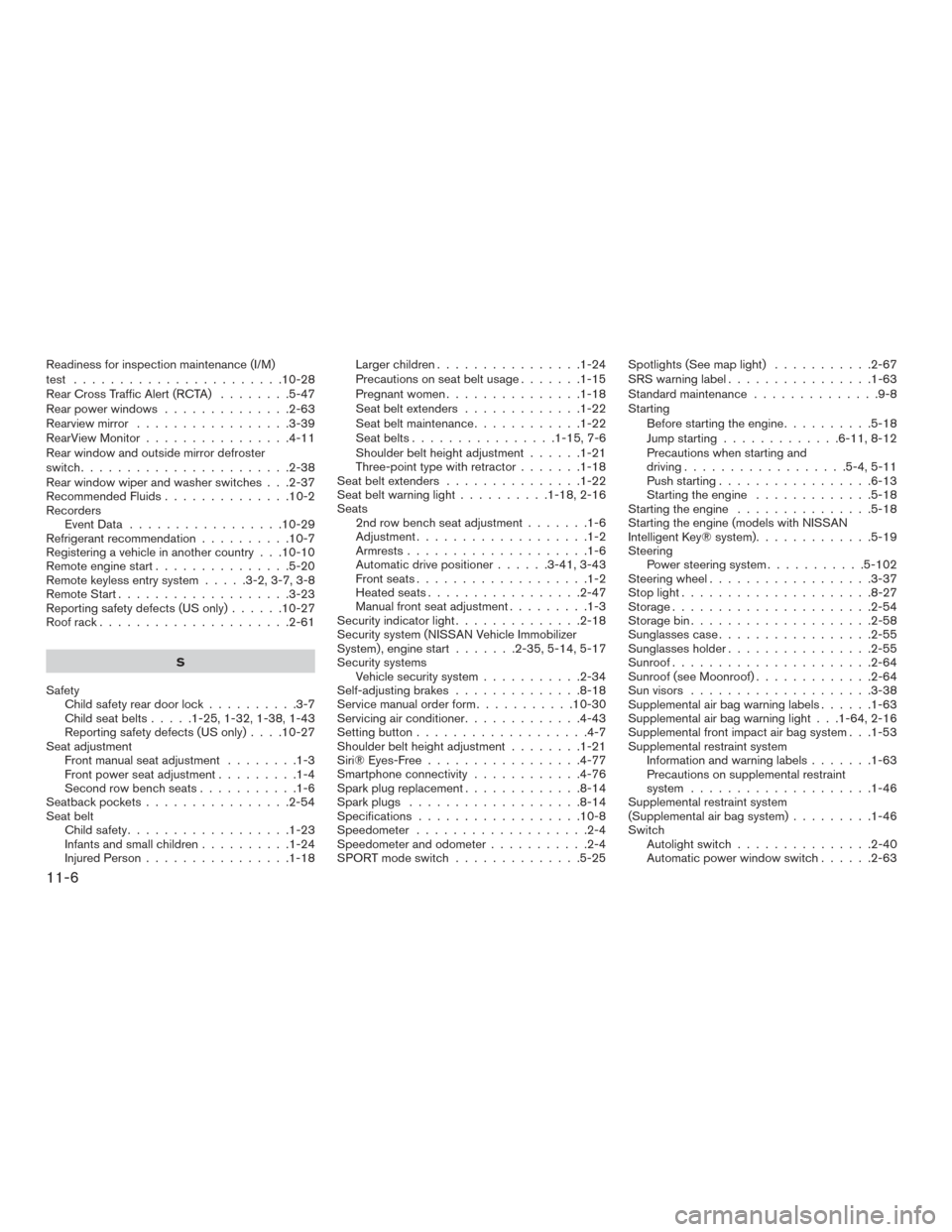
Readiness for inspection maintenance (I/M)
test .......................10-28
Rear Cross Traffic Alert (RCTA)........5-47
Rear power windows ..............2-63
Rearview mirror .................3-39
RearViewMonitor................4-11
Rear window and outside mirror defroster
switch .......................2-38
Rear window wiper and washer switches . . .2-37
Recommended Fluids ..............10-2
Recorders EventData .................10-29
Refrigerant recommendation ..........10-7
Registering a vehicle in another country . . .10-10
Remote engine start ...............5-20
Remote keyless entry system .....3-2,3-7,3-8
Remote Start ...................3-23
Reporting safety defects (US only) ......10-27
Roof rack .....................2-61
S
Safety Child safety rear door lock ..........3-7
Childseatbelts.....1-25,1-32,1-38,1-43
Reporting safety defects (US only) ....10-27
Seat adjustment Front manual seat adjustment ........1-3
Front power seat adjustment .........1-4
Second row bench seats ...........1-6
Seatback pockets ................2-54
Seat belt Childsafety..................1-23
Infantsandsmallchildren..........1-24
Injured Person ................1-18 Larger children
................1-24
Precautions on seat belt usage .......1-15
Pregnant women ...............1-18
Seat belt extenders .............1-22
Seatbeltmaintenance............1-22
Seatbelts................1-15,7-6
Shoulder belt height adjustment ......1-21
Three-point type with retractor .......1-18
Seatbeltextenders ...............1-22
Seat belt warning light ..........1-18,2-16
Seats 2nd row bench seat adjustment .......1-6
Adjustment...................1-2
Armrests ....................1-6
Automatic drive positioner ......3-41,3-43
Frontseats...................1-2
Heatedseats.................2-47
Manual front seat adjustment .........1-3
Security indicator light ..............2-18
Security system (NISSAN Vehicle Immobilizer
System) , engine start .......2-35,5-14,5-17
Security systems Vehicle security system ...........2-34
Self-adjusting brakes ..............8-18
Service manual order form ...........10-30
Servicing air conditioner .............4-43
Setting button ...................4-7
Shoulder belt height adjustment ........1-21
Siri® Eyes-Free .................4-77
Smartphone connectivity ............4-76
Sparkplugreplacement.............8-14
Sparkplugs ...................8-14
Specifications ..................10-8
Speedometer ...................2-4
Speedometer and odometer ...........2-4
SPORT mode switch ..............5-25 Spotlights (See map light)
...........2-67
SRSwarninglabel................1-63
Standard maintenance ..............9-8
Starting Before
starting the engine ..........5-18
Jump starting .............6-11,8-12
Precautions when starting and
driving ..................5-4,5-11
Push starting .................6-13
Starting the engine .............5-18
Starting the engine ...............5-18
Starting the engine (models with NISSAN
Intelligent Key® system) .............5-19
Steering Power steering system ...........5-102
Steering wheel ..................3-37
Stoplight.....................8-27
Storage......................2-54
Storagebin....................2-58
Sunglasses case .................2-55
Sunglasses holder ................2-55
Sunroof......................2-64
Sunroof(seeMoonroof).............2-64
Sun visors ....................3-38
Supplemental air bag warning labels ......1-63
Supplemental air bag warning light . . .1-64, 2-16
Supplemental front impact air bag system . . .1-53
Supplemental restraint system Information and warning labels .......1-63
Precautions on supplemental restraint
system ....................1-46
Supplemental restraint system
(Supplemental air bag system) .........1-46
Switch Autolightswitch...............2-40
Automatic power window switch ......2-63
11-6